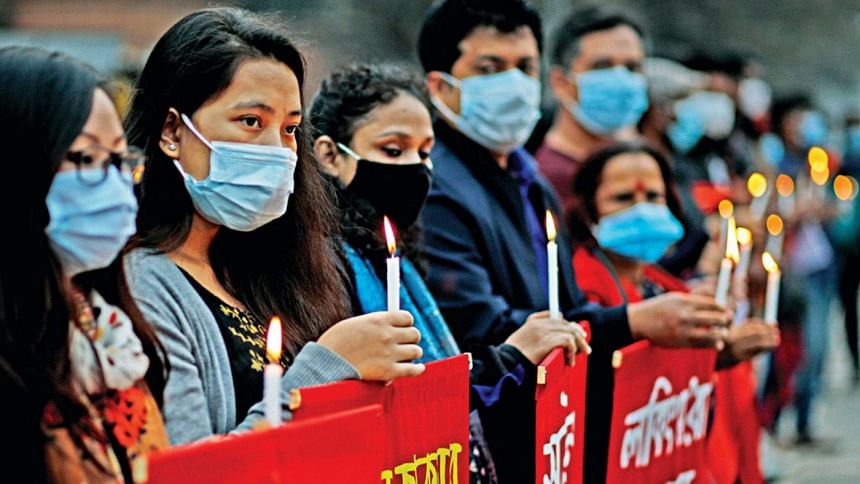Understanding the manifold oppression of Indigenous women

Twenty five years ago, on June 12, 1996, Kalpana Chakma, organising secretary of the Hill Women's Federation, was abducted in the dead of the night. There has been no trace of her ever since. The perpetrators who raped two teenage Marma sisters in 2018 walk free today, and violence against Indigenous women continues. In August 2019, local high school headmaster Samor Kanti Datto, from Ruma upazila in Bandarban, raped a Marma girl and recorded the act on his phone, but it wasn't until September this year that he was arrested.
Writing about gender-based violence against Indigenous women who were violated in ways that are unique to them is an emotionally taxing task. It makes me helplessly question when it will ever stop, or whether I can just divert my attention away. Yet, there is no better time to address gender-based violence against Indigenous women, an issue that is multidimensional—tied to our lands and identity.
Natural resource management in the Chittagong Hill Tracts (CHT) is complex and incredibly political. The traditionally jhum land is owned by the village rather than an individual, managed according to Indigenous customs. The construction of Kaptai dam in the early 1960s was a catastrophic event for Indigenous communities—it submerged 54,000 acres of arable land. The International Work Group for Indigenous Affairs reports that 100,000 people lost their principal economic base because of it.
However, the woes of land loss didn't stop there. Exploiting the lack of documented ownership, non-Indigenous settlers continue with land-grabbing, and without their land, Indigenous communities cannot survive. A report by Kapaeeng Foundation revealed that between March and June 2020, at least 6,504 acres of Indigenous land were either fully occupied or under a process of occupation. A lot of gender-based violence in the CHT region is driven by unresolved land disputes. Perpetrators use terror and rape as the main weapon to suppress Indigenous peoples' land claims. Kapaeeng Foundation also found that, only in 2017, an estimated 56 Indigenous women were assaulted by 75 alleged perpetrators—most of them non-Indigenous.
Lack of access to medical and legal services in remote areas deter Indigenous women and girls from reporting violence against them. They navigate a justice system that doesn't recognise their Indigenous language and traditions. Discriminatory practices such as non-cooperation of local administrations add to the human rights violations. On top of that, non-Indigenous settlers bring with them their patriarchal social codes, and make sense of Indigenous society through patriarchal lenses. Many settlers hold onto beliefs that Indigenous women are exotic and delicate. Women's clothes have grown longer, and scarves are now wrapped around them to avoid the eyes of the non-Indigenous. Indigenous women are also faced with verbal and physical harassment, subjected to frequent checks on their commute to markets.
Even in the 1997 Peace Accord, gender issues were not directly addressed, although it can be argued that gender equity is addressed in an indirect manner through "reserved" seats for women in the District Council and Regional Council. In her article "Indigenous Women: A Gender Perspective," Chandra K Roy writes that Indigenous women were targeted for their ethnicity and gender, which centred on their central role as the transmitters of their culture to future generations. In analysing the use of rape as an instrument in the struggle for power, she mentions a cultural significance of raping "enemy women"—especially women of a different race, religion or political affiliation. The otherisation of Indigenous women is evident in more subtle instances of exoticisation, such as in 2019, when a vlogger posted a video on Facebook where he interviewed a minor Mro girl on her marital status, what a viewer needed to do to marry her, and whether she could dance for him.
When we're taught about social constructs in predominantly Bengali institutions, we learn that women are stereotyped as weak, in need of protection, and kept at home. If we think about sexism centring Indigenous women, we come up against entirely different stereotypes: The exotic breed, the mountain climbers.
This exoticisation demotes them into a subhuman status linked to hyper-sexualisation. On July 14, 2020, a domestic help agency based in Uttara, Dhaka circulated a flyer featuring a Garo woman that read "Delivery within 24 hours, once booked." The insidiousness of this racist undertone, comparing the Garo women to products, is all the more obvious when you realise how vulnerable such domestic workers can be—in February 2019, a Garo teenager was raped by the man who employed her as a domestic worker at his house in Kalachandpur, Gulshan.
While the community faces a gradual loss of ownership of resources, male members often become sole inheritors of property. In this way, Indigenous women face a double burden of discrimination—from settlers and also within their own communities. According to rights activist Muktasree Chakma Sathi, with the exception of Garos and Khasis, most Indigenous communities are patriarchal. Hence, most women lack inheritance rights to properties. "What if women marry non-Indigenous men, and Indigenous properties are further lost?" is used as a common justification. As such, forced and early marriages are rationalised as necessary to ensure cultural preservation. "Marrying out" for Indigenous women indicates an exile from their communities and identities. Denying them the right to make autonomous decisions regarding their own sexuality and marriage is seen as a solution to conserve Indigenous populations. Furthermore, women are not even paid equally for their labour in cultivation.
This unfairness has roots beyond what meets the eye. In February 2020, Manusher Jonno Foundation published a report titled "Gender-Based Violence (GBV) and access to justice for ethnic women and girls in CHT." It reported 45 percent of respondents faced gender-based violence at their workplace, and 44 percent were subjected to domestic abuse. The respondents identified perpetrators to be local thugs, political elites and co-workers. Eighty-two percent of those experiencing domestic violence saw the husband as the main perpetrator.
Patriarchy within Indigenous communities proclaims women's rights as private, cultural and domestic affairs. They are considered divisive and disruptive. Indigenous women exercising agency are accused of being disloyal to their communities. Education is deemed a double-edged sword that only knives the women. "If a woman is 'too' educated, they will make their own decisions!" they say. Where will our women go?
What only adds to the disproportionate pressure faced by Indigenous women is that they are seen as the carriers of group identity. A glance on social media shows Indigenous women being harassed simply for wearing clothes of other cultures. Strikingly, nothing is said to Indigenous men doing the same!
Is it okay to justify violations of women's human rights in the name of upholding culture? Is it culture that lies at the root of women's oppression, or the practices that deny women equity? While culture can be used as an excuse to violate human rights, it can also be used to promote rights by emphasising cultural values of fairness.
Women's rights have been formally codified as human rights in the Convention on the Elimination of All Forms of Discrimination against Women (CEDAW). Indigenous peoples' human rights have been codified in the recently adopted UN Declaration on the Rights of Indigenous Peoples. Yet, rights of Indigenous women remain a contentious issue—domestically and internationally.
Activist Catharine MacKinnon's definition of violence against women incorporates two dimensions: we are women systemically and systematically. Systemic means socially patterned, including harassment, rape and abuse of children. Systematic hints at intentionally organised exploitation. Indigenous women are targets of both gendered forms of violence, and gendered effects of violence that targets Indigenous communities as a whole. Their reality is a particularly racialised form of misogyny and a particularly misogynistic form of racism that targets only them.
The experience of Indigenous women often remains beyond comprehension to the world around them. Can we fight or heal what we can't understand or articulate?
Myat Moe Khaing is a marketing strategist at a multinational company, who takes an interest in Indigenous and gender politics.

 For all latest news, follow The Daily Star's Google News channel.
For all latest news, follow The Daily Star's Google News channel. 



Comments